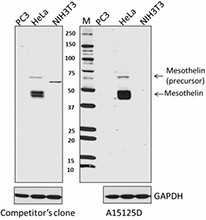- Clone
- A15125D (See other available formats)
- Regulatory Status
- RUO
- Other Names
- Antigen recognized by antigen K1, megakariocyte potentiating factor (MPF), soluble MPF, mesothelin related protein
- Isotype
- Mouse IgG2b, κ
- Ave. Rating
- Submit a Review
- Product Citations
- publications

-

Total cell lysates (15µg protein) from PC3 (negative control), HeLa and NIH3T3 were resolved by 4-20% Tris-Glycine gel electrophoresis, transferred to nitrocellulose, and probed with 0.5 µg/mL purified anti- Mesothelin antibody (clone A15125D) and competitor’s antibody used at manufactures recommended concentration (upper) or loading control GAPDH (clone Poly6314) antibody (lower). Proteins were visualized by chemiluminescence detection using a goat anti-mouse-IgG secondary antibody conjugated to HRP for clone A15125D, and a donkey anti-rabbit IgG Antibody conjugated to HRP for competitor’s antibody and GAPDH. Lane M is the MW ladder. -

IHC staining using purified anti-Mesothelin (clone A15125D) on formalin-fixed paraffin-embedded human tonsil tissue. Following antigen retrieval using 1X Citrate Buffer (Cat. No. 420902), the tissue was incubated with (B) or without (A) 10 μg/mL of antibody overnight at 4°C, followed by incubation with 2.5 μg/mL of Alexa Fluor® 647 goat anti-mouse IgG (Cat. No. 405322) for one hour at room temperature. Nuclei were counterstained with DAPI (blue) (Cat. No. 422801), and the slide was mounted with ProLong™ Gold Antifade Mountant. The image was captured with a 40X objective. Scalebar = 50 μM
Mesothelin (MSLN) was initially cloned from a library of human pancreatic cancer cells. It was also identified by a monoclonal antibody, MAb K1, which recognized a glycoprotein present on the surface of mesothelial cells. The human MSLN gene encodes a ~71 kD precursor protein of 622 amino acids. The C-terminal glycosylphosphatidylinositol (GPI) anchor addition signal is removed (cleavage site: Ser598) and the latter replaced with a GPI anchor. The MSLN precursor is cleaved by furin at Arg295 into two products, a ~31 kD mature megakaryocyte potentiating factor (MPF residues Ser34 - Arg286) and a ~40 kD GPI-anchored membrane-bound mature mesothelin starting from Glu296. The 40 kD GPI-anchored mesothelin can be released by treatment with phosphatidylinositol-specific phospholipase C. Soluble mesothelin specifically binds to ovarian carcinoma cell line OVCAR-3, mediated by the cancer antigen 125 (CA125), a mucin-like glycoprotein on the surface of tumor cells. CA125 and mesothelin are co-expressed in advanced grade ovarian adenocarcinoma, and it has been speculated that CA125 might contribute to the metastasis of ovarian cancer to the peritoneum by initiating cell attachment to the mesothelial epithelium via binding to mesothelin. Also, mesothelin and CA125/mucin 16 (CA125/MUC16) are co-overexpressed at the invading edges of pancreatic cancer tissues, and their expression correlates with poor survival rates. Mesothelin is highly expressed in several human cancers including malignant mesothelioma, pancreatic, ovarian, cholangiocarcinoma, and lung adenocarcinoma.
Product DetailsProduct Details
- Verified Reactivity
- Human
- Antibody Type
- Monoclonal
- Host Species
- Mouse
- Immunogen
- Human recombinant mesothelin
- Formulation
- Phosphate-buffered solution, pH 7.2, containing 0.09% sodium azide.
- Preparation
- The antibody was purified by affinity chromatography.
- Concentration
- 0.5 mg/ml
- Storage & Handling
- The antibody solution should be stored undiluted between 2°C and 8°C.
- Application
-
WB - Quality tested
IHC-P - Verified - Recommended Usage
-
Optimal concentration of usage is 0.1 - 0.5 µg/mL for WB. For immunohistochemistry on formalin-fixed paraffin-embedded tissue sections, a concentration range of 1.0 - 10.0 µg/mL is suggested. The optimal concentration should be determined by titration for each individual assay of interest.
- Application Notes
-
Precursor: 70 kDa. Mature form (N-glycosylated): 46-48kDa.
Clone A15125D does not cross react with mouse (in-house tested). - RRID
-
AB_2687055 (BioLegend Cat. No. 696302)
Antigen Details
- Structure
- The human MSLN gene encodes a ~71 kD precursor protein of 622 amino acids. The MSLN precursor is cleaved into two products, a ~31 kD mature megakaryocyte potentiating factor and a ~40 kD GPI-anchored membrane-bound mature mesothelin
- Distribution
-
Mesothelial cells lining the pleura, peritoneum, and pericardium and tumor cells
- Function
- Cell adhesion; may promote cancer cell survival, proliferation, and metastasis; confers resistance to cytotoxic drug-induced apoptosis
- Interaction
- Cancer cells
- Ligand/Receptor
- CA125/MUC16
- Biology Area
- Cancer Biomarkers, Cell Adhesion, Cell Biology
- Molecular Family
- Cytokines/Chemokines
- Antigen References
-
1. Kojima T, et al. 1995. J. Biol. Chem. 270:21984.
2. Chang K and Pastan I. 1996. Proc. Natl. Acad. Sci. USA 93:136.
3. Rump A, et al. 2004. J. Biol. Chem. 279:9190.
4. Bharadwaj U, et al. 2011. Mol. Cancer 10:106.
5. Chen SH, et al. 2013. Sci. Rep. 3:1870.
6. Tang Z, et al. 2013. Anticancer Agents Med. Chem. 13:276. - Gene ID
- 10232 View all products for this Gene ID
- UniProt
- View information about Mesothelin on UniProt.org
Related Pages & Pathways
Pages
Related FAQs
Other Formats
View All Mesothelin Reagents Request Custom Conjugation| Description | Clone | Applications |
|---|---|---|
| Purified anti-Mesothelin | A15125D | WB,IHC-P |
Compare Data Across All Formats
This data display is provided for general comparisons between formats.
Your actual data may vary due to variations in samples, target cells, instruments and their settings, staining conditions, and other factors.
If you need assistance with selecting the best format contact our expert technical support team.









Follow Us